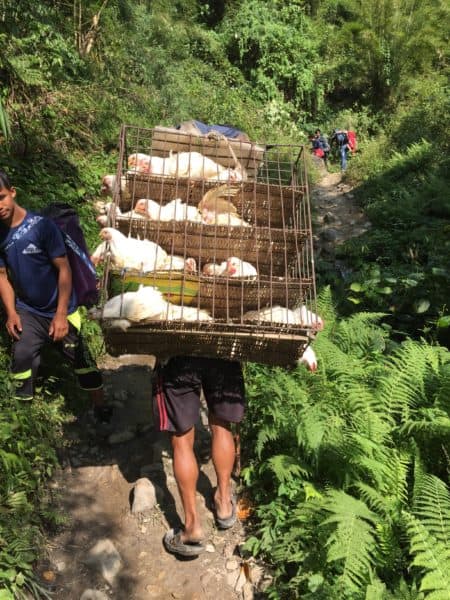 I’m glad my phone tracks the number of stairs climbed, because I lost count after the first hour. I had read voraciously to prepare for our family’s Himalayan trek. Everyone mentioned the scenery. Very few mentioned the stairs. According to my phone, we climbed around 163 flights of stairs each day. That’s the number of floors in the Burj Khalifa, the tallest building in the world. I guess that’s fitting since we were in the Himalayas, the tallest mountains in the world.
I’m glad my phone tracks the number of stairs climbed, because I lost count after the first hour. I had read voraciously to prepare for our family’s Himalayan trek. Everyone mentioned the scenery. Very few mentioned the stairs. According to my phone, we climbed around 163 flights of stairs each day. That’s the number of floors in the Burj Khalifa, the tallest building in the world. I guess that’s fitting since we were in the Himalayas, the tallest mountains in the world.
Getting there
Most Himalayan trek routes last for a week or more. The route to Annapurna base camp can take 3 weeks. We didn’t have that kind of time, so we did a short trek – just three days. Based on a friend’s recommendation, I booked the trip through Bold Adventures Nepal. They provided us with a guide and two porters and made all of the arrangements.
We flew from Kathmandu to Pokhara, a 20 minute flight that saves you a grueling 8 hour drive. Plus now we’ve flown on Yeti Airlines, so that’s good.

It still took 3 hours on the road from Pokhara to get to Kimche, the starting point for our trek.
Life on the Road

We walked for three days, up mountains and down mountains. The first day’s climb took us to Ghandruk (elevation 2000 meters), the capital of the Gurung people. Gurungs are a minority ethnic group in Nepal. Ghandruk is a popular stop on the trekking circuit because it offers good views of Annapurna and other mountains.
Most of the Nepalese in the Himalayas live in villages where there are no roads. Everything gets carried there by mule train or on someone’s back.
We began to notice that prices increased as we went higher. A bottle of water that was 50 rupee ($0.50) in Kimche might be 200 rupee ($2.00) in Jhinhu. That’s understandable since someone had to haul it up there and haul the empty bottle back down.

We left Ghandruk after an early breakfast and set out for Jhinhu. Distances between towns are measured in time, not miles. It’s a four hour walk to Jhinhu, up and down mountains. The reward was a natural hot springs where we could soak our sore muscles and relax.
Our porters carried some of our gear, though I carried my own pack. Time became elastic as we slowly climbed. My sons were the only children that we saw on the trail. I guess most people don’t bring their kids. I’m not sure why.
On the third day we walked to Siwai and met our car. Just a quick 3 hour drive back to Pokhara, which was starting to feel like a metropolis compared to the villages we stayed in.
Though we did see the mountains from the trail, one of the best views we had was from the roof of the Pokhara airport.

Going back
The stereotype of someone doing a Himalayan trek is a young twenty-something or a retiree, and that’s understandable. They’ve got time. I would love to go back to Nepal and do a longer trek. Take my time and relax. Enjoy the scenery more. Drink more tea. Live more simply. And someday I will.

